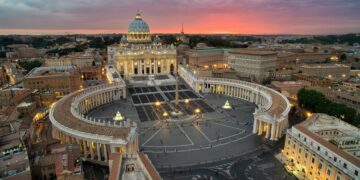The apostles were not the kind of group you might have expected Jesus to send forth on his mission to reach the world. There was nothing special or spectacular about them. The twelve apostles were just ordinary working men. But Jesus formed them into the backbone of the church and gave them the most extraordinary task imaginable: calling the entire world, including the mightiest empire ever known, to repentance and faith in the risen Christ.
You can be sure that any educated, first-century Roman citizen would have laughed at any prediction that within three centuries the Christian faith would be the official faith of the empire. Many wonder how the 12 apostles died, but The New Testament tells of the fate of only two of the apostles: Judas, who betrayed Jesus and then went out and hanged himself, and James the son of Zebedee, who was executed by Herod about 44 AD (Acts 12:2).
Here’s how each of the twelve apostles died.
1. Peter
Also known as Simon, Simon Peter, or Cephus. Peter was the leader of the twelve disciples, he came from the ancient fishing village of Bethsaida along the northern shore of the sea of Galilee. The Bible often portrays Peter as gentle but firm and extremely loyal to Jesus, but he wasn’t perfect. When Jesus was arrested, Peter was afraid for his life, so he disowned him to avoid persecution.
As an uneducated man Peter was untrained in Mosaic law and was a slow learner who repeatedly made mistakes, but when given the opportunity to prove himself, he proved that he was capable. When Jesus walked on water Peter joined him. Peter witnessed numerous miracles including the time Jesus brought a dead girl back to life. In what’s known as the Great Fire of Rome, two-thirds of Rome burned down in 64 A.D, the Emperor Nero blamed Christians and crucified Peter. He was crucified upside down because he felt unworthy of dying the same way as Jesus.
2. James, son of Zebedee
Also known as James the Greater. James, son of Zebedee was one of Jesus’s main disciples and one of two apostles named James. The Bible recounts how he and his brother and fellow disciple John asked Jesus if they should call down fire from Heaven on a town that refused to show them hospitality. In the book of Mark, James asked Jesus if he and John could sit on either side of his throne and promise to follow him into martyrdom. As the only disciple whose martyrdom is recorded in the Bible, James died by sword at the hands of King Herod who most likely beheaded him.
He’s considered the first person to die for Jesus. According to tradition, James was a missionary to Spain and was buried there but he died in Jerusalem during the very early days of the Christian church, so there are some issues with this belief. Nevertheless, for centuries Christians have traveled to his alleged burial place in northwestern Spain on an annual pilgrimage called the Camino de Santiago. Every year around 300,000 people visit the shrine of Saint James the Great in the city of Santiago de Compostela.
3. John, son of Zebedee
John, son of Zebedee was the third member of Jesus’s inner circle of disciples and the brother of James the Greater. He’s one of several apostles who were fishermen before they were called to Jesus. John is best known for a few key events mentioned in the Bible, including when he took Jesus’s mother Mary into his home and cared for her. When news broke that Jesus’s tomb was empty, John and Peter ran there together. John arrived first and the pair were mystified by the pile of linens left behind unaware that Jesus would rise according to the scripture.
According to tradition, John was exiled to the island of Patmos where he wrote the Book of Revelation. He died in 98 A.D from old age, unlike many if not all of the other disciples. Before John’s death, Peter had asked Jesus what would happen to John saying, “Lord, what about him?” Jesus replied by more or less telling Peter that it was none of his business. Leading the disciples to believe that John wouldn’t die but they were wrong, and it is now thought that Jesus meant there were different plans for John’s death than everyone else’s.
4. Andrew
Andrew was a fisherman and the first disciple that Jesus called to serve him. Although he wasn’t one of the three main disciples, he was known as one of the disciples more closely attached to Jesus. Before that Andrew was a disciple of Jesus’s cousin, John the Baptist. Andrew brought Peter to Jesus and told him that Jesus was the Messiah, even though Peter typically gets all the credit for recognizing Jesus as the Messiah. This is just one example of how Andrew almost always came second to his brother in the scriptures.
This was likely because he was either younger or considered less important than Peter. Andrew was crucified in 60 A.D in the Greek city of Patras. According to the acts of Andrew, he was bound to an X-shaped cross known as Saint Andrew’s Cross, because like Peter, he considered himself unworthy of dying the same way that Jesus died. He remained suspended for three days preaching the entire time. Earlier texts described the crucifix used in Andrew’s martyrdom as a traditional cross. In both versions of the story he was bound rather than nailed.
5. Philip
The apostle Philip is only mentioned a handful of times in the New Testament. He’s one of four men named Philip who are discussed throughout the Bible. To make matters even more confusing, early Bible readers often got all these Phillips confused with one another. Very little is known about Philip the apostle. Like Peter and Andrew, he was from the coastal town of Bethsaida on the sea of Galilee. The Bible describes some Greek men seeking Philip out, because they want to see Jesus suggesting that Philip may have spoken better Greek than his fellow disciples.
He’s best known for bringing Nathanael to Jesus. In the book of John, Jesus tests Philip by asking him where to buy bread for a crowd of five thousand hungry people. Later in the scripture Philip asks Jesus to show them God the Father, Jesus responds, “Anyone who has seen me has seen the Father.” There are varying accounts of Philip’s death which likely happened around 80 A.D, one claims that he died from natural causes while other records suggest that Philip was stoned beheaded or crucified upside down.
6. Bartholomew
Not much is known about the apostle Bartholomew other than his name. He may have gone by another name, and he’s closely associated with Philip in the Bible, suggesting that the two had a relationship of some sort. Some believe that Bartholomew was also Nathaniel. In the gospel of John there’s an apostle named Nathaniel who’s closely associated with Philip and Bartholomew isn’t mentioned in John, but others disagree and think that Bartholomew and Nathanael were different people. Bartholomew was likely martyred like most of the other apostles and there are a variety of claims about how he died.
According to the most popular and gruesome version he was flayed alive and then decapitated. Paintings depicting Bartholomew’s death often show him cut up and wearing his skin or holding a flaying knife. Other accounts of Bartholomew’s death suggest that he was beaten and crucified, crucified upside down, crucified taken down while still alive and then flayed and beheaded, beaten unconscious and thrown into the sea, and that he was just beheaded. While the specifics surrounding Bartholomew’s death are unclear due to the conflicting stories, it’s clear that he didn’t die from natural causes or from old age. However, he passed from this world it was likely horrible.
7. Matthew
Also known as Levi. Matthew was a tax collector who collected money for Rome from fellow Jews. In first century Judaism, this was one of the most criticized and hated professions. It was seen as a form of betrayal that represented Rome’s occupation of Israel. So, when Jesus asked Matthew to be one of his disciples it showed that God chooses all sorts of people to do his work, including people who were normally considered outsiders. Matthew is only mentioned seven times in the Bible yet he’s one of the most well-known disciples. According to the gospels, Jesus approached him at a tax collector’s booth and asked Matthew to follow him.
The two then ate dinner at Matthew’s house with many tax collectors and sinners. Jesus did this not as a demonstration of poor character but to show that even the people society considered irredeemable were accepted by God. The circumstances surrounding Matthew’s death are largely a mystery. One account suggests that he died of old age but it’s more likely that he was martyred like most of his fellow disciples. There are various accounts of what may have happened to him, including stories about him being beheaded, stabbed, burned, or stoned.
8. Thomas
Thomas the apostle isn’t mentioned much in the Bible, and the details of his life are conflicting and obscure, but he became well known for his skepticism during one particularly famous event that earned him the nickname “Doubting Thomas”. The gospel of John describes how Thomas doubted Jesus’s resurrection stating to his fellow disciples, “Unless I see the nail marks in his hands and put my finger where the nails were and put my hand into his side I will not believe.”
Jesus appeared and offered to let Thomas touch his wounds like he said he needed to in order to believe that the resurrection was real. This story was the foundation of evidence-based faith and for the concept of people who have not seen and yet have believed. Thomas was martyred on July 3 in 72 A.D. According to tradition he was speared to death in Mylapore, India. Unlike the accounts of most of the other disciples’ deaths there are only a few stories about how Thomas died and they’re all similar.
9. James, son of Alphaeus
The apostle James, son of Alphaeus is only mentioned in the four lists of the apostles meaning that only two things are known for sure about him that his name was James and that his father’s name was Alphaeus. There are numerous speculations about him but none of them can be proven as facts. To make matters even more confusing, while it’s clear that James, son of Alphaeus was a different person than his fellow apostle James, son of Zebedee, there are two other people named James in the Bible one of them is Jesus’s brother also known as James the Just and the other is known as James the Less and it’s unclear whether either of them are the same person as James, son of Alphaeus.
Even the early church struggled with trying to figure this out. Because of all this confusion it’s hard to say how James, son of Alphaeus died. Jesus’s brother James met a violent end when he was pushed from a temple’s pinnacle, beaten with a club and then stoned to death. One account detailing the death of James, son of Alphaeus claims that he was crucified during a preaching mission in Egypt. Another story says that he was stoned to death in Jerusalem. Regardless of how James the apostle died it’s probably safe to say that he was martyred.
10. Thaddaeus
The apostle Jude is known by several names including Jude of James, Judas of James, Thaddeus, Judas Thaddeus, and Lebbaeus. Some people believe that he was Jesus’s brother but there are no clear statements in the Bible about this being the case. So, nobody can say for sure whether both Judes were the same person. It’s hard to speculate about Jude the apostle’s life or death, without considering it as a possibility. However, Jude the apostle was definitely a different person than Judas Iscariot and it’s believed that he went by the nickname Thaddeus to distinguish himself from Judas who wasn’t exactly a well-liked figure of the church during this time.
Tradition holds that Jude the apostle was martyred alongside Simon, the Zealot in what is now the city of Beirut in 65 A.D. At the time the region was part of the Roman province of Syria. Religious artwork often depicts Jude holding an axe which symbolizes how he died. One account claims that his remains were transported from Beirut to Rome in 1665 and were placed in a crypt at Saint Peter’s Basilica where his bones share a tomb with Simon the Zealot.
Another story claims that Jude’s remains were preserved at an Armenian monastery in Kyrgyzstan and that they were kept there at least until the mid-15th century. An ossuary bearing the inscription Judas Thaddeus was found alongside several unmarked ossuaries in Israel’s Jezreel valley. The site was dated to no later than the second century indicating that it could be Jude’s burial place.
11. Simon the Zealot
Simon the Zealot’s name only appears in the four lists of the apostles. Nobody knows what his nickname the Zealot means. One possibility is that he was a member of a Jewish sect called the Zealots who were a revolution-seeking group in search of a messiah. Another is that he was zealous about the study of mosaic law or for Jesus and his teachings. Some early mistranslations of the Bible confuse Simon with Jesus’ brother and inaccurately refer to him as Simon the Canaanite.
This led to the belief that Simon the Zealot was present during Jesus’s first miracle when he turned water into wine, but it’s now thought that this may not have been the case. According to tradition Simon preached in Egypt but almost nothing else is known about him and there are conflicting stories about how he died. The earliest records are from centuries after he died, which makes it even harder to say with any confidence what most likely happened.
During the fifth century the Armenian historian Moses of Turin wrote that Simon was martyred in the Kingdom of Iberia. A compilation of the stories of saints’ lives known as the Golden Legend, claims that Simon the Zealot was martyred in Persia in 65 A.D. Ethiopian Christians have said that he was killed in a central region of Israel called Samaria. One account says that Simon was crucified in Britain in 61 A.D. Another story claims that he was soared in half while eastern tradition holds that he died of old age in the ancient city of Odessa.
12. Judas Iscariot
The most famous or perhaps infamous apostle was Judas Iscariot. Even today his name is synonymous with the word traitor. At one time Judas was probably considered trustworthy. He was the designated treasurer for Jesus and the disciples. Yet the same scripture that describes his job also mentions how untrustworthy he was. Jesus told his disciples at the last supper that he knew one of them was going to betray him. He then turned to Judas and said, “What you are about to do, do it quickly.”
At the time none of the other apostles picked up on what that meant because they assumed Jesus was talking about something money related. According to the Bible, Judas met with some priests and agreed to betray Jesus for 30 pieces of silver. He later approached Jesus while being followed by the armed mob who captured him and took him to be crucified. It is in this way that greed motivated Judas to do something that led to Jesus’s death. He immediately regretted what he did, but his life was in effect ruined.
According to the book of Matthew, Judas hanged himself. The gospel of Luke describes how Judas used the money he received for betraying Jesus to buy a field where he fell head first. According to the scripture, his body burst open, and his intestines spilled out. It’s not clear what this means and both accounts were written after Judas’s death, so it’s possible that the writers got some of the details wrong.
Conclusion
Jesus had prepared his disciples and God used them in a powerful way to alert the world to His good news that Jesus Christ had come into the world to save sinners. These men gave their lives and died so that all could hear the good news that the forgiveness of sins is free to anyone who believes in Jesus Christ and accepts Him as Lord and Savior.


































































































































































































